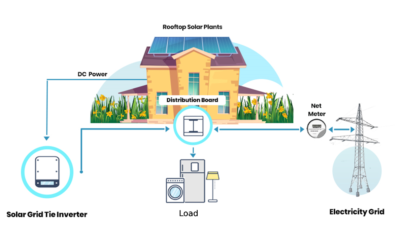Solar power has revolutionized the way we harness renewable energy. Two popular solar power plant setups are on-grid (grid-tie) and off-grid systems, each with its unique technical aspects. In this blog, we’ll explore the technical details of these systems, with a focus on the concept of net metering in on-grid installations.
On-Grid (Grid-Tie) Solar Power Plants
On-grid solar power plants, also known as grid-tie systems, are directly connected to the local utility grid. They function seamlessly with the grid, supplying electricity while also allowing surplus power to flow back into the grid. Here are the key technical details:
- Solar Panels: On-grid systems consist of solar panels, typically composed of photovoltaic cells, which convert sunlight into electrical energy.
- Inverter: The inverter is the heart of an on-grid system. It converts the direct current (DC) electricity generated by the solar panels into alternating current (AC) electricity that can be used in homes and businesses.
- Grid Connection: On-grid systems are connected to the utility grid through a bidirectional meter. This meter records both the electricity consumed from the grid and the excess electricity sent back to the grid.
- Net Metering: One of the standout features of on-grid systems is net metering. It’s like a two-way street for electricity. During sunny days when the system generates more electricity than is consumed, the excess electricity is sent back to the grid, and the meter runs backward, giving you credit. At night or during cloudy days when you need more electricity than your panels produce, you draw power from the grid, utilizing the credits you’ve earned.
- No Energy Storage: On-grid systems do not require energy storage, like batteries, because they rely on the grid as a virtual battery. This keeps installation costs lower than off-grid systems.
Block Diagram

Benefits of On-Grid Systems with Net Metering:
- Efficient use of excess power by feeding it into the grid.
- Reduced reliance on grid power.
- Cost-effective installation due to no need for energy storage.
- Potential for lower electricity bills through credits earned during surplus generation.
Off-Grid Solar Power Plants
In contrast, off-grid solar power plants operate independently of the utility grid. These systems are designed for remote areas where grid connection is impractical. Here’s a look at their technical details:
- Solar Panels: Like on-grid systems, off-grid systems utilize solar panels to convert sunlight into electricity.
- Charge Controller: An essential component of off-grid systems is the charge controller. It regulates the flow of electricity from the solar panels to the battery bank to prevent overcharging or deep discharging.
- Battery Bank: Electricity generated by the solar panels is stored in a battery bank. These batteries store excess energy for use during periods of low sunlight, such as nighttime or cloudy days.
- Inverter: An inverter converts the DC electricity stored in the battery bank into AC electricity for use in homes or businesses.
- Backup Generator (Optional): In some off-grid systems, a backup generator may be included to provide additional power during extended periods of low sunlight.

Benefits of Off-Grid Systems:
- Energy independence in remote locations.
- Reliable power supply even without grid access.
- Ability to store excess energy for use at night or during cloudy days.
Comparison of On grid and Offgrid solar PV power plant as a summery
| Aspect | On-Grid (Grid-Tie) Solar | Off-Grid Solar |
|---|---|---|
| Power Backup | No backup during outages | Built-in battery backup or backup generator for uninterrupted power |
| Cost | Lower initial cost due to no energy storage requirements and grid connection | Higher initial cost due to batteries and backup systems |
| Energy Independence | Relies on the grid, no energy independence | Offers energy independence, ideal for remote areas |
| Grid Reliability | Affected by grid outages | Unaffected by grid outages |
| Solar Panel Sizing | Sized to offset a portion of electricity bills | Sized to meet all energy needs, including nights and cloudy days |
| Maintenance | Low maintenance costs | Batteries require periodic replacement, additional maintenance |
| Environmental Impact | Lower carbon footprint due to reduced grid reliance | Still reduces carbon footprint but may require backup generators running on fossil fuels |
| Return on Investment | Typically shorter payback period due to lower upfront costs | Longer payback period due to higher upfront costs, but potential for complete energy bill savings |
| Suitable Applications | Urban and suburban areas with reliable grid access | Remote locations, cabins, cottages, and areas with unreliable grid access |
| Government Incentives | Eligible for incentives and net metering programs in many areas | Eligible for incentives, but net metering may not be available |
| Scalability | Easy to add more panels to increase capacity | Possible to expand, but additional batteries and equipment may be needed |
In conclusion, on-grid (grid-tie) and off-grid solar power plants each offer unique technical advantages suited to different needs. On-grid systems, combined with net metering, enable you to contribute clean energy to the grid while potentially lowering your energy bills. Off-grid systems, on the other hand, provide energy independence and reliability in remote areas. Understanding these technical details can help you make an informed decision when considering solar power for your specific requirements.
